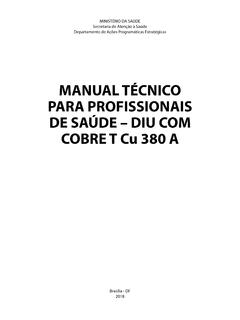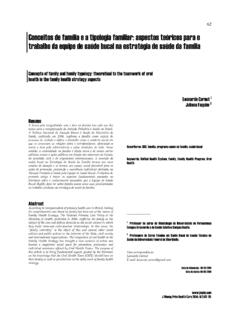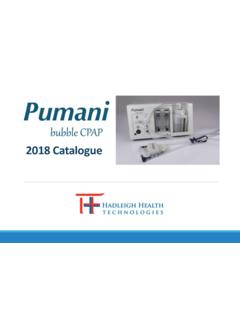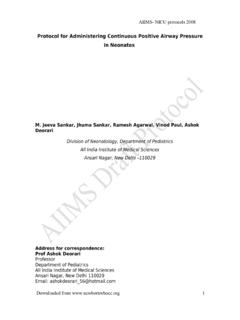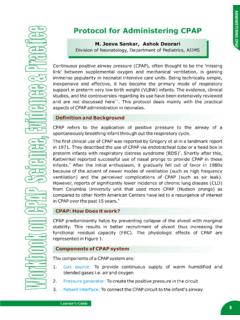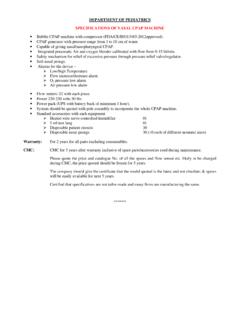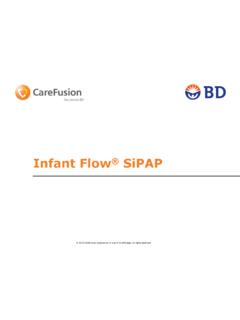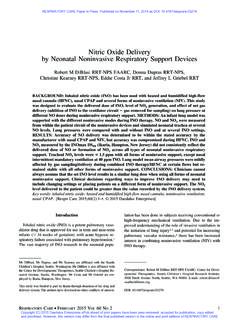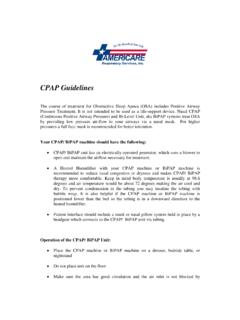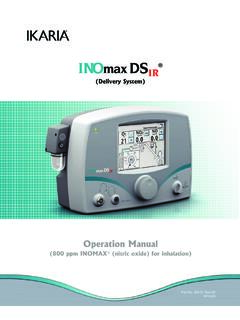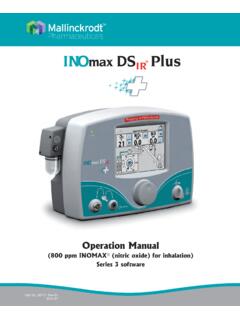Transcription of Bubble nasal CPAP manual - portaldeboaspraticas.iff.fiocruz.br
1 1 Bubble nasal cpap manual Riyadh AL-Kharj Hospital Programme Neonatal intensive care 2005 Amer Ammari, MB, BS Fawaz Kashlan, MD Faisal Ezzedeen, MD Atyah AL-Zahrani, MD John Kawas, RRT Majeed-Saidan, MB. , FRCP Adapted from the NCPAP Education and training manual By Conner, R. de Klerk and A. de Klerk. PREFACE Respiratory Distress Syndrome (RDS) is due to a deficiency of pulmonary surfactant. Seventy one % of very low birth weight infants had RDS, and 35% of them still required oxygen at 36 weeks adjusted age (Vermont Oxford Network 2001). Along with significant mortality, RDS is associated with significant morbidity and high costs to society.
2 Pulmonary surfactant lines the surface of the alveoli in the lung, thereby reducing surface tension and preventing alveolar collapse. Surfactant deficiency results in progressive atelectasis of the alveoli, decreased pulmonary compliance, increased work of breathing, respiratory failure, and lung injury. The earlier the gestational age, at which birth occurs, the higher the risk that severe respiratory distress syndrome will develop. Historically, conventional therapy for this disorder has consisted of continuous positive airway pressure ( cpap ) or mechanical ventilation, along with appropriate supportive care. In the past decade, surfactant replacement has led to significant improvements in survival, particularly for infants less than 1000 grams.
3 However, attempts to treat RDS may lead to lung injury, and secondary complications including bronchopulmonary dysplasia (BPD) and chronic lung 2disease (CLD). This lung injury is thought to result from the effect of mechanical injury due to assisted ventilation, oxygen toxicity, and lung inflammation among other factors. The following materials comprise the Bubble nasal cpap manual . This manual provides a training tool in the administration of nasal cpap using a Bubble bottle system, following guidelines established at The Children s Hospital of New York at New York Presbyterian Medical Center (Columbia-Presbyterian Medical Center).
4 CONTENTS Introduction Section 1: Background and Theory Section 2: Initiation of nasal cpap Section 3: Maintenance of nasal cpap NCPAP Checklist: Maintaining the nasal cpap System Section 4: Complications Associated with nasal cpap Section 5: Removal of nasal cpap Section 6: Respiratory Failure on nasal cpap NCPAP Checklist: Respiratory Failure on nasal cpap Section 7: Troubleshooting the nasal cpap Delivery System References Appendix A: Equipment List and Manufacturers Section 8: Delivery room protocol for the respiratory management of preterm infants 3 INTRODUCTION Purpose The purpose of the nasal cpap Training and Education manual is to provide a training tool in the administration of nasal continuous positive airway pressure ( cpap ) using a Bubble system following guidelines established at Columbia-Presbyterian Medical Center in New York.
5 As you work through this training manual , you will learn the skills to successfully administer nasal cpap to premature infants using a Bubble system. The sections outlined below contain information regarding the theory and the application of the nasal cpap Bubble system. Section One: Background and Theory provides a brief review of the physiology of continuous positive airway pressure , and pertinent literature supporting cpap use in the premature infant. Section Two: Initiation of nasal cpap describes the nasal cpap delivery system and the steps necessary for stabilization and initiation of NCPAP in the delivery room. This chapter describes how to determine the appropriate size and fit of each component in the nasal cpap delivery system.
6 Section Three: Maintenance on nasal cpap describes how to evaluate and to maintain a properly functioning cpap system, including the use of the nasal cpap Checklist: Maintaining the nasal cpap System. Section Four: Complications Associated with nasal cpap describes complications that may occur to infants being treated with nasal cpap . Section Five: Removal of nasal cpap describes the steps involved in determining whether an infant is stable and ready to be removed from the nasal cpap system. Section Six: Respiratory Failure on nasal cpap describes how to evaluate and how to troubleshoot the nasal cpap Bubble system in instances where infants have progressive respiratory failure, including the use of the nasal cpap Checklist: Respiratory Failure on nasal cpap .
7 Section Seven: Troubleshooting the nasal cpap Delivery System focuses on specific common questions and issues arising when using nasal cpap . 4 SECTION ONE BACKGROUND AND THEORY Introduction Respiratory Distress Syndrome (RDS) is due to a deficiency or dysfunction of pulmonary surfactant. Pulmonary surfactant lines the surface of the alveoli in the lung, thereby reducing surface tension and preventing alveolar collapse. Surfactant deficiency results in progressive atelectasis of the lung, decreased pulmonary compliance, increased work of breathing, respiratory failure, and lung injury. Since the initial discovery of the role of surfactant deficiency in the pathogenesis of respiratory distress syndrome, numerous randomized controlled trials have shown that intratracheal instillation of an exogenous surfactant preparation is effective in both the prevention and treatment of RDS.
8 To date, over 33 randomized controlled trials of surfactant replacement therapy involving over 6,000 infants have been reported. Meta-analyses of these randomized controlled trials have shown that, when compared to conventional management without surfactant replacement, surfactant therapy results in a significant decrease in the risk of pneumothorax and mortality. Despite the success of surfactant therapy, a significant number of infants will develop lung injury, as demonstrated by the persistent high rate of chronic lung disease seen in extremely low birth weight infants. nasal continuous positive airway pressure ( cpap ) may represent a less invasive way to maintain lung volume and improve oxygenation.
9 Studies that examined the variation in practice between centers have suggested that the routine use of nasal cpap in the stabilization of very low birth weight infants may reduce the incidence of chronic lung disease. Physiology of cpap continuous positive airway pressure ( cpap ) has been widely used to correct respiratory insufficiency. cpap was used in adults as early as 1936. cpap has been used in infants with RDS since its introduction in 1971. cpap is uniquely suited to address many issues in the pathogenesis of RDS. Clements and colleagues described the importance of surfactant for the stabilization of alveoli at low transpulmonary pressures.
10 Harrison and colleagues recognized the benefit of an increased alveolar pressure during expiration in infants with respiratory distress syndrome and demonstrated that eliminating the infant s ability to grunt by use of an endotracheal tube is associated with a decrease in Pa02. cpap works by maintaining positive pressure in the airway during spontaneous breathing, thereby increasing functional residual capacity and improving oxygenation in infants with RDS. cpap does this by stabilizing airspaces that have a tendency to collapse during expiration due to surfactant deficiency. A variety of mechanisms of action of nasal cpap have been proposed.
